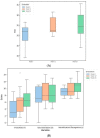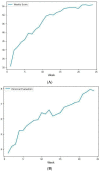Maximizing Participation in Olfactory Training in a Sample with Post-COVID-19 Olfactory Loss
- PMID: 39061470
- PMCID: PMC11274705
- DOI: 10.3390/brainsci14070730
Maximizing Participation in Olfactory Training in a Sample with Post-COVID-19 Olfactory Loss
Abstract
Purpose: This study aims to highlight the feasibility of an olfactory training program entirely monitored through online media in COVID-19 patients.
Methods: Classic olfactory training was performed with a sample with olfactory loss due COVID-19 (n = 11). Participants were engaged on a weekly video call in order to improve adherence and collect information regarding the number of correct answers and the individuals' perception of olfactory function. The olfactory status after training was compared to two groups, one composed of participants who contracted COVID-19 but did not report olfactory loss (n = 11) and a sample composed of healthy participants (n = 11).
Results: The experimental group showed improvements throughout the training period (TDI score on week 0 was 20.3 (5.6) and 24.6 (4.3) for week 12, and on week 24 was 25.4 (6.2) (F = 5.115, df = 2, 20, p = 0.016), and post hoc tests showed that participants significantly improved their TDI score in W12 compared to W0 (SMD = 0.869, p = 0.041) and in W24 compared to W0 (SMD = 0.859, p = 0.041). The experimental group showed lower scores when compared with both groups, and the no OT COVID-19 group showed lower scores than the healthy control group, even though they did not report olfactory alterations.
Conclusions: Findings suggest that the strategies applied to improve adherence were successful since 100% of the sample completed the training adherence, offering a valuable framework for future olfactory training studies.
Keywords: COVID-19; olfactory dysfunction; olfactory rehabilitation; olfactory training; therapeutic approach.
Conflict of interest statement
The authors have no relevant financial or non-financial interests to disclose.
Figures






Similar articles
-
Olfactory Dysfunction following COVID-19 and the Potential Benefits of Olfactory Training.J Clin Med. 2023 Jul 18;12(14):4761. doi: 10.3390/jcm12144761. J Clin Med. 2023. PMID: 37510876 Free PMC article.
-
Effectiveness of olfactory training in COVID-19 patients with olfactory dysfunction: a prospective study.Eur Arch Otorhinolaryngol. 2023 Mar;280(3):1255-1263. doi: 10.1007/s00405-022-07665-4. Epub 2022 Sep 25. Eur Arch Otorhinolaryngol. 2023. PMID: 36153785 Free PMC article.
-
Olfactory Training in Post-COVID-19 Persistent Olfactory Disorders: Value Normalization for Threshold but Not Identification.J Clin Med. 2022 Jun 8;11(12):3275. doi: 10.3390/jcm11123275. J Clin Med. 2022. PMID: 35743346 Free PMC article.
-
Therapeutic options of post-COVID-19 related olfactory dysfunction: a systematic review and meta-analysis.Rhinology. 2023 Feb 1;61(1):2-11. doi: 10.4193/Rhin22.221. Rhinology. 2023. PMID: 36173148
-
Impact of summer programmes on the outcomes of disadvantaged or 'at risk' young people: A systematic review.Campbell Syst Rev. 2024 Jun 13;20(2):e1406. doi: 10.1002/cl2.1406. eCollection 2024 Jun. Campbell Syst Rev. 2024. PMID: 38873396 Free PMC article. Review.
References
-
- WHO Coronavirus (COVID-19) Dashboard. [(accessed on 2 August 2023)]. Available online: https://covid19.who.int.
-
- Cherry G., Rocke J., Chu M., Liu J., Lechner M., Lund V.J., Kumar B.N. Loss of Smell and Taste: A New Marker of COVID-19? Tracking Reduced Sense of Smell during the Coronavirus Pandemic Using Search Trends. Expert Rev. Anti-Infect. Ther. 2020;18:1165–1170. doi: 10.1080/14787210.2020.1792289. - DOI - PMC - PubMed
-
- Lescure F.-X., Bouadma L., Nguyen D., Parisey M., Wicky P.-H., Behillil S., Gaymard A., Bouscambert-Duchamp M., Donati F., Hingrat Q.L., et al. Clinical and Virological Data of the First Cases of COVID-19 in Europe: A Case Series. Lancet Infect. Dis. 2020;20:697–706. doi: 10.1016/S1473-3099(20)30200-0. - DOI - PMC - PubMed
-
- Lechien J.R., Chiesa-Estomba C.M., De Siati D.R., Horoi M., Le Bon S.D., Rodriguez A., Dequanter D., Blecic S., El Afia F., Distinguin L., et al. Olfactory and Gustatory Dysfunctions as a Clinical Presentation of Mild-to-Moderate Forms of the Coronavirus Disease (COVID-19): A Multicenter European Study. Eur. Arch. Otorhinolaryngol. 2020;277:2251–2261. doi: 10.1007/s00405-020-05965-1. - DOI - PMC - PubMed
LinkOut - more resources
Full Text Sources
Miscellaneous

